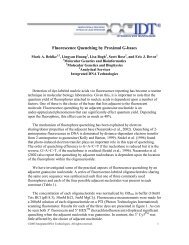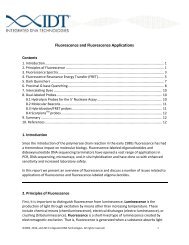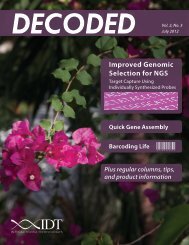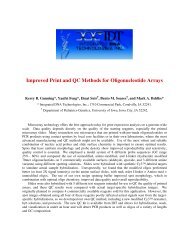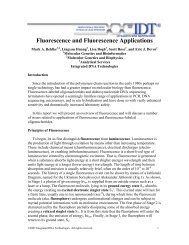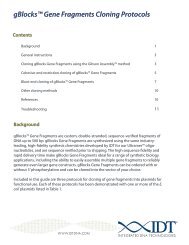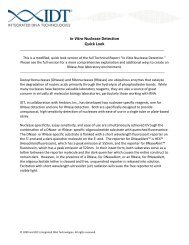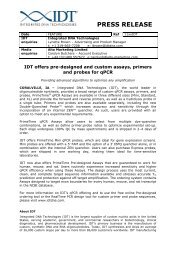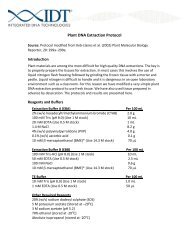Chemical Synthesis of Oligonucleotides - Integrated DNA ...
Chemical Synthesis of Oligonucleotides - Integrated DNA ...
Chemical Synthesis of Oligonucleotides - Integrated DNA ...
Create successful ePaper yourself
Turn your PDF publications into a flip-book with our unique Google optimized e-Paper software.
was catalyzed by the discovery in that year <strong>of</strong> the enzyme, <strong>DNA</strong> ligase. Khorana realized thatthey could synthesize overlapping, complementary oligodeoxynucleotides and assemble thegene using the ligase. In 1968, Khorana received the Nobel Prize in Physiology or Medicine fortheir interpretation <strong>of</strong> the genetic code and its function in protein synthesis. In 1970 theypublished the first completely synthetic gene, the 77bp yeast tRNA Ala gene [1]. In this Naturearticle, they noted, “Unpublished experiments by two <strong>of</strong> us have given encouraging results onthe use <strong>of</strong> <strong>DNA</strong> polymerase for replication <strong>of</strong> the gene in the presence <strong>of</strong> suitable primers.” [1].Some have speculated that this statement may have been the beginning <strong>of</strong> the invention <strong>of</strong>PCR.3. Contemporary Oligonucleotide <strong>Synthesis</strong>In spite <strong>of</strong> the successes <strong>of</strong> researchers like Khorana, chemical synthesis <strong>of</strong> oligonucleotidesremained labor intensive and inefficient throughout the 1970’s and into the early 1980’s. In1983, a breakthrough was achieved in synthesis chemistry that made it possible to make longeroligonucleotides and to make them much more efficiently. The new synthesis process wasbased on the use <strong>of</strong> phosphoramidite monomers as building blocks and the use <strong>of</strong> tetrazolecatalysis [2]. A phosphoramidite monomer is a very different synthesis unit compared to itspredecessors. First, a phorphoramidite is a normal nucleotide but with protection groups, suchas a trityl group, added to its reactive amine, hydroxyl, and phosphate groups. Theseprotection groups prevent unwanted side reactions and force the formation <strong>of</strong> the desiredproduct during synthesis (Figure 3). Theprotection groups are removed after thecompletion <strong>of</strong> the synthesis process.Second, the link to the solid support is madethrough the 3’ carbon and synthesisproceeds 3’ to 5’ rather than the 5’ to 3’synthesis used previously (Figure 4A). Thesolid support is a 5 micron controlled poreglass bead (CPG) with holes and channelswhere the protected nucleotide is attached(Figure 4B). The advances in oligonucleotidesynthesis chemistries have resulted insubstantial increases in quality and yield withthe added advantage <strong>of</strong> decreasing cost.This is particularly important since each Figure 3. Protection Groupsoligonucleotide has to be custom madedependent on the needs <strong>of</strong> the individual researcher.Phophoramidite synthesis begins with the 3’-most nucleotide and proceeds through a series <strong>of</strong>cycles composed <strong>of</strong> fours steps that are repeated until the 5’-most nucleotide is attached.These steps are deprotection, coupling, capping, and stabilization.©2005, 2010, and 2011 <strong>Integrated</strong> <strong>DNA</strong> Technologies. All rights reserved. 4



